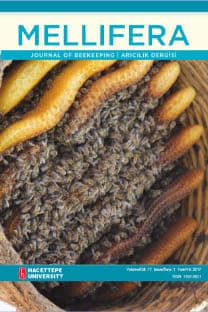Manuka Balının Ana Antibakteriyel Bileşeni Metilglioksal’ın Antimikrobial Aktivitesinin Değerlendirilmesi
Nektardan elde edilen dihidroksiasetonun, enzimatik olmayan dönüşümü ile oluşan metilglioksal (MGO), manuka balındaki temel antibakteriyel bileşendir. Bu çalışmanın MGO’nun Escherichia coli, Pseudomonas aeruginosa ve Staphylococcus aureus üzerindeki etkisini araştırmaktır. Tüm deneylerde hazır olarak alınan MGO (Sigma-Aldrich) kullanılmıştır. MGO’nun antimikrobiyal aktivitesinin ölçülmesi için agar difüzyon testi kullanılmıştır. Sonuçlar, test edilen tüm bakterilerin MGO çözeltilerine karşı anlamlı olarak duyarlı olduğunu göstermektedir. İstatistikler analizler, MGO’ya karşı S. aureus’un en hassas, P. aeruginosa’nın ise en az hassas olduğunu göstermektedir. Çalışma sonuçları umut vericidir ve MGO’nun potansiyelinin ortaya çıkarılması için ileri çalışmaların yapılası gereklidir.
Anahtar Kelimeler:
Metilglioksal, Manuka balı, Disk difüzyon testi
Evaluation of Antimicrobial Activity of Methylglyoxal -The Major Antibacterial Component of Manuka Honey
Methylglyoxal (MGO) is the major antibacterial compound in manuka honey, which is formed by a non-enzymatic conversion of nectar-derived dihydroxyacetone. The aim of this study was to investigate the effect of MGO on Escherichia coli, Pseudomonas aeruginosa and Staphylococcus aureus. Purchased MGO (Sigma-Aldrich) was used for all tests. Disc diffusion test was used for evaluating the antimicrobial activity of MGO. The results showed that each tested bacteria species is susceptible to MGO solutions significantly. Statistical analyses revealed that S. aureus is the most and P. aeruginosa is the least susceptible bacterial strain to MGO solutions. The results of this study are encouraging, and further studies are necessary to study out MGO’s potential.
Keywords:
Methylglyoxal, Manuka honey, Disc diffusion test,
___
- [1] LEVY, S B ; MARSHALL, B. (2004) Antibacterial resistance worldwide: Causes, challenges and responses, Nature Medicine, 10, S122-129.
- [2] KIM, S; LIEBERMAN, T D; KISHONY, R; (2014) Alternating antibiotic treatments constrain evolutionary paths to multidrug resistance, Proc Natl Acad Sci U S A, 111(40): 14494–14499.
- [3] MAVRIC, E; WITTMANN, S; BARTH, G; HENLE, T, (2008) Identification and quantification of methylglyoxal as the dominant antibacterial constituent of Manuka (Leptospermum scoparium) honeys from New Zealand, Mol. Nutr. Food Res., 52, 483–489.
- [4] ADAMS, C J; BOULT, C H; DEADMAN, B J; FARR, J M; GRAINGER, M N C; MANLEY-HARRIS, M; SNOW, M J (2008) Isolation by HPLC and characterisation of the bioactive fraction of New Zealand manuka (Leptospermum scoparium) honey, Carbohydr. Res., 343: 651–659.
- [5] ADAMS, C J: MANLEY-HARRIS, M; MOLAN, P C (2009) The origin of methylglyoxal in New Zealand manuka (Leptospermum scoparium)honey, Carbohydrate Research, 344(8):1050–1053.
- [6] ATROTT, J; HENLE, T (2009) Methylglyoxal in manuka honey—correlation with antibacterial properties, Czech Journal of Food Sciences, 27:163-165.
- [7] TAORMINA, P J; NIEMIRA, B A; BEUCHAT, L R (2001) Inhibitory activity of honey against foodborne pathogens as influenced by the presence of hydrogen peroxide and level of antioxidant power, Int J Food Microbiol, 69:217-225.
- [8] CHAUHAN, A; PANDEY, V; CHACKO, K M, KHANDAL R K (2010) Antibacterial activity of raw and processed honey, Electron J Biol, 5:58-66.
- [9] SHERLOCK, O; DOLAN, A; ATHMAN, R; POWER, A; GETHIN, G; COWMAN, S; HUMPHREYS, H (2010) Comparison of the antimicrobial activity of Ulmo honey from Chile and Manuka honey against methicillin-resistant Staphylococcus aureus, Escherichia coli and Pseudomonas aeruginosa, BMC Complement Alternat Med; 10: 47.
- [10] MANDAL, M D; MANDAL, S (2011) Honey: its medicinal property and antibacterial activity, Asian Pacific Journal of TropicalBbiomedicine, 1(2): 154-60.
- ISSN: 1302-5821
- Başlangıç: 2001
- Yayıncı: Hacettepe Üniversitesi
Sayıdaki Diğer Makaleler
Investigation of Antioxidant and Antimicrobial Activity of Different Multifloral Honeys
Sevim ÇİFTÇİ YEGİN, Duygu ODABAŞ ALVER, Figen ÇİÇEK, Aytaç GÜDER
Pollen and Achene Morphology of Some Centaurea L. Taxa (Asteraceae), Turkey
Oktay BIYIKLIOĞLU, Talip ÇETER, Barış BANİ
Oktay BIYIKLIOĞLU, Talip ÇETER, Barış BANİ
Halime ATAR, Barış BANİ, Talip ÇETER
Sevim ÇİFTÇİ YEGİN, Duygu ODABAŞ ALVER, Figen ÇİÇEK, Aytaç GÜDER
Aygün SCHİESSER, Derya ŞİMŞEK, İlkyaz SARIMEHMETOĞLU, Gonca ESENDEMİR
